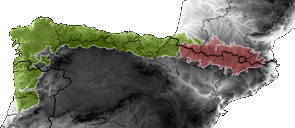Background
This project has its origin in the Memorandum of Collaboration (MoC) signed between JBA and RBGK in 2012 and the MoC signed between SS Aranzadi and RBGK in 2013. These agreements have resulted in several seed collecting campaigns in the Cantabrian territory and Pyrenees (some of them joint field trips); the strengthening of the relationship between institutions, and the exchange of knowledge and experience.
In 2012, 88 collections were duplicated in the MSB (50 new species). All collections were of high quality, with excellent digital data and herbarium vouchers. This year higher numbers of new species for the MSB are expected.
Potential for new seed collections
The plant diversity of the Pyrenees is one of the highest in Europe (5.500 species) and the Cantabrian territory also has outstanding plant diversity (3.590 species). In both cases, this high diversity is due to the complexity of these mountain ranges with a high altitudinal gradient and a high diversity of climates, geology and ecosystems.
Around 200 taxa are endemic to the Pyrenees and 400 taxa are endemic to the Pyrenees-Cantabrian territory. Several boreoalpine and alpine species are at their southern distribution limit here and some species have isolated populations. In the Cantabrian territory-Pyrenees there are several threatened habitats at European level and several species of the alpine mountain zones, adapted to cold weather, are being replaced by plant species of lower mountain zones due to the global warming process.
We expect that approximately 50% of the collected material will be potential new seed collections for the MSB.
In this project it will be a priority to collect several populations of target species to ensure the conservation of the genetic diversity along the Pyrenees-Cantabrian territory. For that reason the number of collections will be higher than the number of species collected.
Endemic plants like Borderea pyrenaica, B. chouardii (ancient species relatives of yam), attractive plants like Ramonda myconi, Lilium pyrenaicum, Fritillaria nigra or Aster pyrenaeus (the last with potential use in horticulture) or plants with medicinal components like Valeriana pyrenaica or Thymus nervosus could be target species for this project.
Project purpose
The main purpose of this project is the conservation of an important group of priority plant species (endemic, threatened, protected and rare) through the following objectives:
- To collect seeds of priority plant species in their natural habitats and seeds of keystone species of target habitats in the Cantabrian territory-Pyrenees axis to ensure their long term conservation in seed banks (seed collections).
- To develop and fine tune germination and cultivation protocols for these taxa to ensure their long term conservation in botanical gardens (live plant collections) and to facilitate a successful re-establishment in nature if needed (restoration programmes).
- To disseminate the knowledge gained and the project results, and to make available seed and plant material to stakeholders for use in species and habitat restoration programmes.
- To increase public awareness of the effect of climate change on high mountain flora through plant exhibitions in several botanical gardens.




